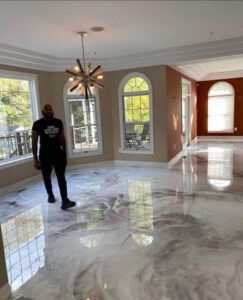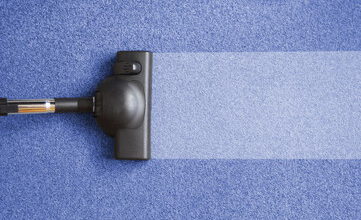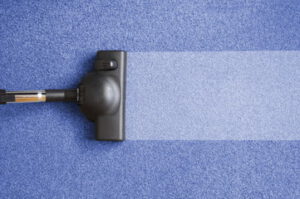When a high-quality epoxy floor is applied correctly, it will last a long time. However, if you choose lower-quality water-based or one-coat epoxies, they will peel off or wear out quickly.

This is due to abrasion. This is what will cause your epoxy floor to become dull, lose its gloss, and start wearing through the coating to bare concrete. For professional help, contact Top Coat Technicians now!
Whether you need a floor for your car shop, warehouse, or another type of commercial facility, epoxy flooring is an excellent choice. The material is durable and resists stains and corrosion. It can be applied to a variety of surfaces and is easy to clean. The floor is also easy to walk on and does not create dust or scuff marks like plain concrete.
The epoxy coating is designed to resist harsh chemicals and withstand impact from heavy machinery. It is resistant to abrasions and scratches, which means that dropped objects or chemical spills will not damage it. In addition, the floor is water-resistant and prevents fires from spreading. This makes it a good option for facilities that handle hazardous materials, such as chemical plants and oil refineries.
Epoxy floors are a great choice for residential use as well. They can last for 10 to 20 years in a home, provided that they are properly cared for. For example, you should sweep them regularly and keep them free of debris. It is also important to call a professional flooring contractor when the floors show signs of damage, such as cracks or scuffing.
Another advantage of epoxy flooring is that it helps to minimize the amount of dirt and cement that is released onto other surfaces in a room or garage. This is especially important if you have children or pets that play on the floor. Additionally, the protective coating is easy to sweep and vacuum.
One of the biggest disadvantages of epoxy flooring is that it requires a lengthy curing process, which can be difficult for busy businesses or homeowners. This can cause delays in business operations and lead to lost revenue. Additionally, the long timeframe for curing can be expensive for businesses that need to shut down operations during this period.
Ultimately, the longevity of an epoxy floor depends on the quality of the product and the manner in which it is installed. If the floor isn’t prepped correctly, the epoxy may not bind to the concrete underneath it and will begin to wear down quickly. If the floor isn’t cleaned regularly, chemicals and moisture will build up and wear down the epoxy surface.
Affordable
Whether you’re remodeling your home or looking to raise your property value, an epoxy floor is a wise investment. It provides a protective coating that will keep your floors in pristine condition for years to come. It can even prevent cracks and damage caused by extreme wear and tear. With a variety of colors and finishes, it’s easy to find an epoxy product that complements your space.
While the initial investment may be high, you’ll save money on costly repairs and replacements over time. In addition, an epoxy floor will keep your belongings safe from scratches and other stains. Furthermore, the long-lasting material won’t become damaged from excessive moisture or standing water. It’s important to choose the right company for your epoxy flooring, as cheaper services often use less durable materials.
Epoxy floor coatings are a popular option for commercial and industrial facilities, but they can be an affordable choice for residential spaces as well. It’s crucial to research companies and read reviews before making a decision. Choose a contractor with an excellent track record and a professional staff.
Most epoxy companies charge by the square foot, so it’s best to get an estimate before starting the process. You can also compare prices between competing businesses to make sure you’re getting the best deal. However, low pricing isn’t always indicative of quality, and you should avoid choosing a company that offers prices too good to be true.
The cost of an epoxy floor will vary based on several factors, including the size of your garage or workspace, room preparations, and epoxy type. Water-based epoxy costs between $30 and $50 per gallon, and it emits lower levels of volatile organic compounds (VOCs). Solvent-based epoxy is more expensive at $45 per gallon, but it provides superior durability. Finally, there is 100% solid epoxy, which is the most expensive but also the longest-lasting.
Many flooring companies require a specialized license, so it’s important to check their credentials before hiring them. You should also make sure they are bonded and insured to protect you from any issues that may arise during the installation process.
Easy to Maintain
Epoxy floors are resistant to stains and spills, which makes them an easy choice for high traffic areas such as garages or showrooms. However, oil, car chemicals and other spills can cause discoloration if they are not cleaned up as soon as they occur. This type of damage can result in costly downtime and lost productivity, which is why it is so important to keep a regular cleaning schedule to prevent these problems from occurring.
A regular sweeping of your epoxy floor will remove dirt, debris and other particles that can cause scratches and degrade the shine of your flooring surface. Regular sweeping can also help you spot any cracks or other signs of wear and tear early so that you can repair them before they become serious issues.
Using mats or plywood to protect your epoxy floors from heavy equipment or vehicles is another way to extend the life of your flooring and make it easier to maintain. This will help to prevent large dents or gouges in the flooring that may require expensive repair work or even a replacement floor.
It is important to sweep and mop your epoxy floors regularly, at least once a week. A simple solution of warm water and a mild dishwashing soap is usually all you need to clean most epoxy flooring. Avoid using any cleaners that contain acids, especially citrus or vinegar, as these can damage the epoxy coating.
Epoxy floors can gather dust and other particles over time, particularly in high-traffic areas. If these particles aren’t swept or vacuumed away, they can scratch the epoxy surface and eventually degrade its shine and gloss. Regular sweeping and mopping will prevent this from happening and keep your flooring looking its best.
If you notice a tough stain on your epoxy flooring, you can use a soft kitchen sponge and diluted ammonia to gently scrub the area. Be sure to rinse the floor well to remove any residual cleaners or soap.
Versatile
With a variety of designs and colors to choose from, epoxy flooring offers an array of possibilities for both residential and commercial spaces. Its high level of customization also means it can be tailored to create a specific sense of style, whether it’s warm and welcoming or clean and contemporary.
Its durability and ease of upkeep make it a popular choice for garages and basements, but it can be used in commercial environments as well. For example, epoxy floors are often found in warehouses and manufacturing plants because of their chemical resistance. They can be customized with anti-slip additives to help prevent accidents in areas where employees work.
Epoxy floors are very easy to clean, which is great for homes with kids and pets. They can easily be wiped down and they’re also resistant to water, so stains won’t set in. Plus, if you want to keep your garage safe for your car, an epoxy floor will prevent tire wear on the surface.
The material’s versatility extends to its decorative options, too. You can choose from full color flake coatings, which use custom blends of colored flakes that are applied to the base coat while it’s still wet. Or, you can opt for a metallic epoxy coating, which adds an element of glimmer and intensity.
In addition to the safety elements mentioned above, epoxy floors can be made safer with various traction additives. Polymer grit, mortar, aluminum oxide, and gravel can be mixed into the mixture to alter its slick surface for more gripping effects.
Epoxy flooring is very durable, so it can withstand heavy traffic without damage or chipping. However, it’s important to hire a professional team for installation and follow the manufacturer’s instructions. If you’re not careful, your new flooring may not last as long as it should and could eventually need to be replaced.
It’s also worth noting that the installation process can be very time-consuming. For this reason, it’s best to hire a company that is experienced with epoxy installations and can guarantee their work. Otherwise, you may experience prolonged downtime in your business and lost revenue.

